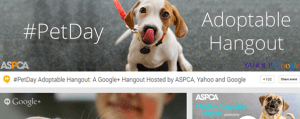A new report from Business Insider has revealed some interesting insights about the user demographics for popular social networks like Facebook, LinkedIn and YouTube.
Some of the findings might surprise you!
We pulled out three intriguing facts and unpacked what they could mean for your charity or non-profit organization.
#1. “Facebook skews significantly female”

What does this mean for your nonprofit?
We noticed the rise of Facebook as an important trend for charities and nonprofits simply by looking at traffic patterns across FrontStream’s online fundraising products. Facebook is currently the top referring website to fundraising pages and donation forms in North America.
Many of the most popular campaigns shared on Facebook are peer-to-peer events or challenges related to hospital fundraising, health and disease research. You only have to look at the recent popularity of #ALSicebucketchallenge for proof of that this year!
In our Fundraising with Facebook whitepaper, we discovered that peer-to-peer charity fundraising apps on Facebook were more popular with women (63%) than men (35%). Research also shows us that women are more likely than men to donate to charitable causes, particularly health-related charities.
Women also log into and update Facebook more frequently, averaging 55% more posts on their Facebook timelines than men. This means that women have more opportunities to see and share your charity’s posted content.
If your online fundraising includes a peer-driven or crowdsourced campaign, make sure that you plan activities on Facebook to take advantage of the natural overlap between women who enjoy social networking and the online donors you’re targeting for support.
Did you know? Facebook out-performs other social networks in fundraising by a wide margin. According to our September data from Artez and FirstGiving, approximately 90% of online donations referred from all social networks are referred by Facebook, with Twitter following much farther behind at about 5%.
#2. “YouTube reaches more adults aged 18 to 34 than any single cable TV network”

What does this mean for your nonprofit?
If you’re a fan of our nonprofit webinar series, you’ve already been hearing a lot about the power of online video for telling stories! Video can help motivate and inspire your viewers to action on behalf of your good cause.
Fortunately, it’s no longer necessary to have expensive A/V equipment or an editing studio to produce engaging high-quality video. In a world where most laptops have webcams, and smartphones have video capability, it’s never been easier to use video to reach out to your online audience.
For instance, one of the most exciting applications of Google+ is the “Hangouts on Air” feature. This tool allows your organization to livestream a broadcast that can then be automatically posted to YouTube.
Have you considered hosting a chat with the experts related to your cause? You could also use a Google Hangout to help organize your volunteers, create a video fundraising toolkit for participants in an event, or even produce an adorable online Adopt-A-Thon like ASPCA did!
Take a look at how Giving Tuesday uses Hangouts and YouTube to share information about how charities can prepare for December 2nd’s day of philanthropy.
Being active on YouTube is also good for your SEO (search engine optimization). Have you noticed how relevant YouTube content is returned when you search a keyword or phrase on Google?
Did you know? YouTube has built-in editing features, allowing you to combine multiple videos, edit clips, face-blur crowd footage, and add notations.
#3. “LinkedIn is actually more popular than Twitter among U.S. adults”

What does this mean for your nonprofit?
As Business Insider points out, LinkedIn's core user demographic is well-educated professionals between the ages of 30 and 49. This description likely matches one of the established donor or volunteer profiles at your non-profit organization.
There are so many easy ways to engage with your supporters on LinkedIn. Creating a “company page” for your organization is a great way to start. LinkedIn has built a “nonprofit” microsite with resources to help you grow your presence on the network.
Make sure you regularly post your online content inside LinkedIn and prompt your followers to share it. You might have noticed the popular “Pulse” newsfeed designed to curate the most popular articles that your network is talking about.
If you’re like most NPOs, you’re already in the habit of creating a call-to-action for Twitter or Facebook, but don’t forget your many supporters who might prefer LinkedIn! Be specific and directly encourage your blog readers and newsletter subscribers to share your content with their connections on LinkedIn.
Major Gifts professionals have known the power of LinkedIn for prospect research for some time. LinkedIn gives you a greater understanding of how individuals are professionally connected. You might discover that a prospect you’re profiling has volunteered with one of your donors or corporate sponsors on another cause or event. LinkedIn is also a great place to find employees, board members, volunteers, and internship candidates.
Did you know? LinkedIn launched a volunteering profile for users to talk about the causes and events they have supported. Don’t forget to tell your supporters, donors and staff members to fill out these sections and proudly tell the world they have worked on behalf of your organization. You can also post your own volunteering opportunities inside LinkedIn For Volunteers.
Have any of these emerging trends on popular social networks surprised you? Let us know how your organization is learning from the changing demographics on these platforms!
Get the latest trends and topics delivered to your inbox!
Subscribe to FrontStream's Blog